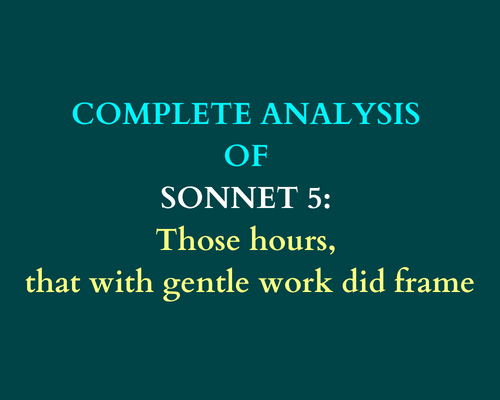COMPLETE ANALYSIS OF SONNET 5: Those hours, that with gentle work did frame
Shakespeare’s sonnets are a testament to his mastery of language and have been captivating readers for centuries.
You are reading the complete analysis of Shakespeare’s Sonnet 5: Those hours, that with gentle work did frame

William Shakespeare and Sonnet
Shakespeare, known for his intricate and emotionally profound sonnets, published a collection of 154 of his own sonnets in 1609. This publication has become famous for its complexity and beauty.
Sonnets are a form of poetry that typically consist of 14 lines. Shakespeare’s sonnets follow this basic structure. The poet usually writes each line in iambic pentameter. There are ten syllables in each line, with alternating stressed and unstressed syllables.
They explore a wide range of themes, including love, beauty, time, mortality, and the nature of art.
SUMMARY OF SONNET 5: Those hours, that with gentle work did frame
Sonnet 5 is a reflection on the effects of time on beauty.
The poem describes how time, represented by the changing seasons, can turn once-beautiful things ugly. Through the metaphor of distillation, the speaker suggests that without taking measures to capture and preserve beauty, it would disappear forever, emphasizing the idea that we must make an effort to retain what we find beautiful and valuable.
However, even though flowers lose their appearance in winter, their substance remains sweet.
In summary, the sonnet highlights the inevitable passage of time and how it affects beauty, but also suggests that something eternal remains within beauty.
STRUCTURE OF SONNET 5: Those hours, that with gentle work did frame
Sonnet 5 follows the traditional structure of a Shakespearean sonnet, consisting of three quatrains followed by a final couplet. It uses iambic pentameter, a poetic meter comprising ten syllables with alternating stressed and unstressed syllables in each line.
The rhyme scheme of Sonnet 5 is
- Line 1-4: ABAB
- Line 5-8: CDCD
- Line 9-12: EFEF
- Line 13-14: GG
The poem explores the theme of time and its effects on beauty, with each quatrain presenting a different aspect of this theme.
The final couplet of a sonnet provides a resolution to the preceding quatrains. It implies that poetry can capture and preserve the essence of beauty, even as physical beauty inevitably fades over time.
Overall, the tight structure of Sonnet 5 enables the speaker to develop their ideas within a strict poetic form.
POETIC DEVICES IN SONNET 5: Those hours, that with gentle work did frame
William Shakespeare’s Sonnet 5 employs the following poetic devices:
- Alliteration: “frame” and “fair” in line 1 create alliteration.
- Personification: The speaker personifies “hours” in line 1, describing them as doing “gentle work” to create something beautiful. In line 5, the speaker personifies time as a “conqueror” who eventually destroys beauty.
- Metaphor: In the first line of the poem, the hours are likened to skilled laborers who delicately work to frame the beloved’s face.
- Repetition: The repetition of “that” at the beginning of each line creates a parallel structure that emphasizes the significance of each idea being presented.
- Rhyme: The sonnet follows a traditional rhyme scheme, with the last word of each line rhyming according to the pattern ABBAABBA CDCDCD.
- Enjambment: The sentences do not end at the end of each line, but continue to the next line. This creates a sense of flow and continuity between the lines.
- Imagery: The images of the “hours” working to “frame” the beloved’s face creates a vivid picture in the reader’s mind.
- Metaphor: The comparison in line 8 of the beloved’s beauty to a “liquid prisoner pent in walls of glass” suggests that beauty is fragile and temporary.
- Synecdoche: The phrase “roses in her cheeks” in line 12 is a synecdoche, referring to the entire face by just one part of it.
- Allusion: The line “even so my cheeks” in line 9 alludes to the common practice of distilling flowers to preserve their fragrance.
ANALYSIS OF FIRST STANZA OF SONNET 5: Those hours, that with gentle work did frame
Those hours, that with gentle work did frame
The lovely gaze where every eye doth dwell,
Will play the tyrants to the very same
And that unfair which fairly doth excel;
The speaker suggests that even the most beautiful things are subject to the destructive power of time.
In Sonnet 5, “those hours” refers to time that can erode and destroy even the most beautiful things over time. The phrase “gentle work” refers to the delicate and painstaking effort that went into creating the object of beauty. However, even this gentle work cannot withstand the ravages of time forever. Thus, it suggests that the passing of time and the slow accumulation of experiences have created something beautiful.
The “lovely gaze” refers to a person’s beautiful eyes, which are often admired and can attract attention. The phrase “where every eye doth dwell” suggests that the beautiful object captures the attention of all who see it. This reinforces the notion that beauty is a powerful force that can inspire awe and admiration in beholders.
However, the third line introduces a note of pessimism. Here, the speaker suggests that the passing of time will eventually destroy the beauty that was created through gentle work.
The phrase “unfair which fairly doth excel” suggests that time can make even the most beautiful things appear ugly and decrepit. The contrast between what was once lovely and what has now become distorted underscores the destructive power of time.
Overall, these lines suggest that beauty is a transient and vulnerable quality that is subject to the passage of time. The speaker urges the reader to appreciate beauty while it lasts, as time will inevitably destroy it.
ANALYSIS OF SECOND STANZA OF SONNET 5: Those hours, that with gentle work did frame
For never-resting time leads summer on
To hideous winter, and confounds him there;
Sap checked with frost, and lusty leaves quite gone,
Beauty o’er-snowed and bareness every where:
This stanza discusses the inevitability of the changing seasons and how time affects the natural world. The speaker laments the fleeting nature of youth and beauty, comparing it to the seasonal cycle of summer and winter.
The speaker suggests that time never rests and continues to move forward, leading summer towards its inevitable end in winter. The phrase “never-resting time” refers to the relentless passage of time that leads to the changing of the seasons. Thus, time is a constant force that drives the changing seasons forward.
The speaker describes the transformation of summer into winter. The phrase “Sap checked with frost” describes the sudden onset of winter and its effect on the trees, which lose their leaves and become barren. It implies that winter is a difficult and unpleasant season that is confusing and disorienting.
The phrase “lusty leaves quite gone” describes how the once vibrant and green leaves fall from the trees, leaving them bare. It describes the physical effects of winter on the natural world. The cold checks the sap in trees, causing the leaves to wither and fall off.
The final line captures the stark contrast between the lushness of summer and the barrenness of winter. The speaker highlights the vulnerability of beauty to time, which can strip it away and leave emptiness and desolation.
Overall, these lines emphasise the inevitability of time’s passage and its impact on the natural world. The poet uses imagery to depict how winter strips away beauty and vitality, emphasizing time’s unstoppable power.
ANALYSIS OF THIRD STANZA OF SONNET 5: Those hours, that with gentle work did frame
Then were not summer’s distillation left,
A liquid prisoner pent in walls of glass,
Beauty’s effect with beauty were bereft,
Nor it, nor no remembrance what it was:
The poem discusses how beauty is fleeting and how memories of it can fade over time. Trapping summer’s beauty in glass would diminish its impact and power.
The phrase “distillation left” means extracting essential qualities, such as beauty, from a substance. “Liquid prisoner pent in walls of glass” describes trapped beauty that cannot affect the world. It emphasizes the importance of preserving the fleeting nature of beauty through art and memory.
If beauty were to be lost in this way, there would be no way to remember or appreciate it. “Beauty’s effect with beauty were bereft” means that beauty’s power would be lost and forgotten if trapped in glass. It implies that memories of beauty are incomplete and cannot capture its full impact.
Overall, these lines highlights the fleeting nature of beauty and the importance of preserving it through art and memory. The poet stresses poetry and art’s significance in capturing beauty’s essence, making it memorable and celebrated for future generations.
ANALYSIS OF LAST COUPLET OF SONNET 5: Those hours, that with gentle work did frame
But flowers distilled, though they with winter meet,
Leese but their show; their substance still lives sweet.
Sonnet 5 reflects on the transience of beauty and the enduring essence of some things beyond their physical state.
The phrase “Leese but their show” suggests that while the physical beauty of the flowers is lost, their essence and sweetness remain intact.
The final phrase, “their substance still lives sweet,” reinforces the idea that beauty’s essence can survive despite physical beauty’s inevitable fading. Thus, beauty is both fleeting and enduring, preserved through poetry as an enduring essence beyond physical beauty.
Sonnet 5 uses the metaphor of distilling flowers to imply that poetry can capture and preserve the essence of beauty, despite the fading of physical beauty over time.
Overall, the poem implies that despite the impermanence of certain things, their essence can be preserved and captured. Preserving memories is crucial, even after the physical components that gave rise to them have vanished.
THEMES OF SONNET 5: Those hours, that with gentle work did frame
The themes of Sonnet 5 include:
- The fleeting nature of beauty: The poem suggests that beauty is impermanent and subject to the ravages of time. The “hours” that worked to create beauty in the past can become “tyrants” and destroy that same beauty.
- The power of memory: The poem emphasizes the importance of memory in preserving the essence of beauty. Without memory or some form of preservation, beauty’s effect would be lost forever.
- The inevitability of change: The poem suggests that change is an inherent part of life, and that even the most beautiful things are subject to this change. The progression from summer to winter is used as a metaphor for this idea.
- The value of preservation: Sonnet 5 stresses the need to preserve beauty, implying that its essence can be captured and retained even after the loss of tangible aspects. The metaphor of distilling flowers to preserve their essence reinforces this idea.
SETTING OF SONNET 5: Those hours, that with gentle work did frame
Sonnet 5 does not have a specific setting described within the poem itself. The poem reflects on beauty and time, rather than telling a story with a specific setting.
The poem contains natural imagery that could suggest a pastoral or natural setting, but the text does not explicitly describe a specific setting.
CONCLUSION OF SONNET 5: Those hours, that with gentle work did frame
Sonnet 5 is a contemplation on the fleeting nature of beauty and the power of memory to preserve its essence. The poem uses the metaphor of the changing seasons to emphasise the inevitability of change and the impermanence of beauty.
The first quatrain shows creation and destruction of beauty, while the second emphasises the significance of preservation and memory.
Metaphor of distilling flowers in the final couplet suggests beauty’s essence can survive even as physical beauty fades.
Overall, the poem presents a reflective and somewhat melancholic view of the nature of beauty and its relationship to time.
COMPLETE ANALYSIS OF SONNET 4: Unthrifty Loveliness, Why Dost Thou Spend

